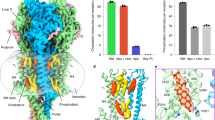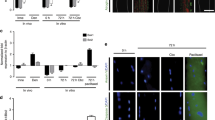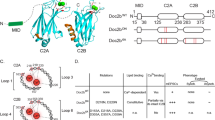Abstract
THE quantity of transmitter released from presynaptic nerve terminals is in part determined by the amplitude of the action potential1,2 invading the nerve terminals, and by the amount of a specific calcium-compound available at some strategic site3. Large reductions in external Na+ concentration, however, which would be expected to reduce the size of the propagated action potential4, do not greatly alter the output of acetylcholine at cholinergic nerve endings5,6. This might be explained if it were supposed that the reduction in Na+ concentration also increased the amount of available calcium-compound at the strategic site; Na+ deficient solutions might then maintain the release of transmitter in spite of the reduction of the amplitude of the action potential. On this hypothesis a Na+ deficient solution might be expected to increase the amount of transmitter released when the calcium, concentration is low. Such an increase in transmitter release has been found in the experiments reported below.
This is a preview of subscription content, access via your institution
Access options
Subscribe to this journal
Receive 51 print issues and online access
$199.00 per year
only $3.90 per issue
Buy this article
- Purchase on Springer Link
- Instant access to full article PDF
Prices may be subject to local taxes which are calculated during checkout
Similar content being viewed by others
References
Liley, A. W., J. Physiol., 134, 427 (1956).
Takeuchi, A., and Takeuchi, N., J. Gen. Physiol., 45, 1181 (1962).
Del Castillo, J., and Katz, B., J. Physiol., 124, 560 (1954).
Hodgkin, A. L., and Katz, B., J. Physiol., 108, 37 (1949).
Hutter, O. F., and Kostial, K., J. Physiol., 129, 159 (1955).
Burke, W., Ph.D. thesis, Univ. London (1956).
Fatt, P., and Katz, B., J. Physiol., 115, 320 (1951).
Martin, A. R., J. Physiol., 130, 114 (1955).
Takeuchi, N., J. Physiol., 167, 128 (1963).
Del Castillo, J., and Katz, B., J. Physiol., 124, 553 (1954).
Lüttgau, H. C., and Niedergerke, R., J. Physiol., 143, 486 (1958).
Douglas, W. W., and Rubin, R. P., J. Physiol., 167, 288 (1963).
Douglas, W. W., and Poisner, A. M., J. Physiol., 172, 1 (1964).
Author information
Authors and Affiliations
Rights and permissions
About this article
Cite this article
KELLY, J. Antagonism between Na+ and Ca2+ at the Neuromuscular Junction. Nature 205, 296–297 (1965). https://doi.org/10.1038/205296a0
Issue Date:
DOI: https://doi.org/10.1038/205296a0
This article is cited by
-
Inhibitory Action of Sodium Ions on Transmitter Release at the Motor End-plate
Nature (1967)
-
Untersuchungen �ber die Noradrenalin-Freisetzung durch Acetylcholin am perfundierten Kaninchenherzen
Naunyn-Schmiedebergs Archiv f�r Pharmakologie und Experimentelle Pathologie (1967)
Comments
By submitting a comment you agree to abide by our Terms and Community Guidelines. If you find something abusive or that does not comply with our terms or guidelines please flag it as inappropriate.



